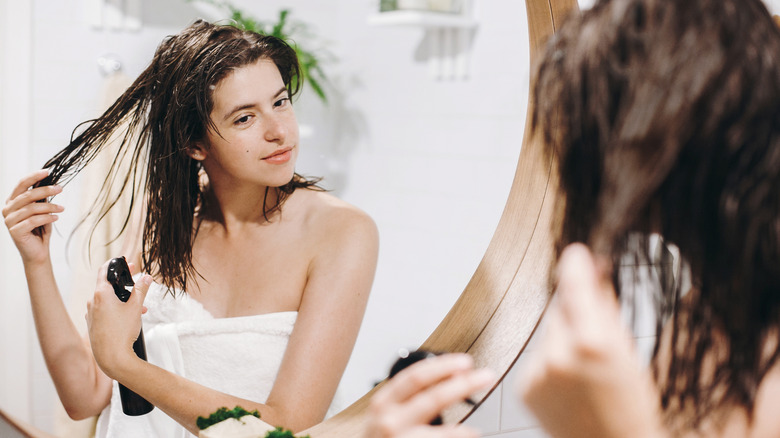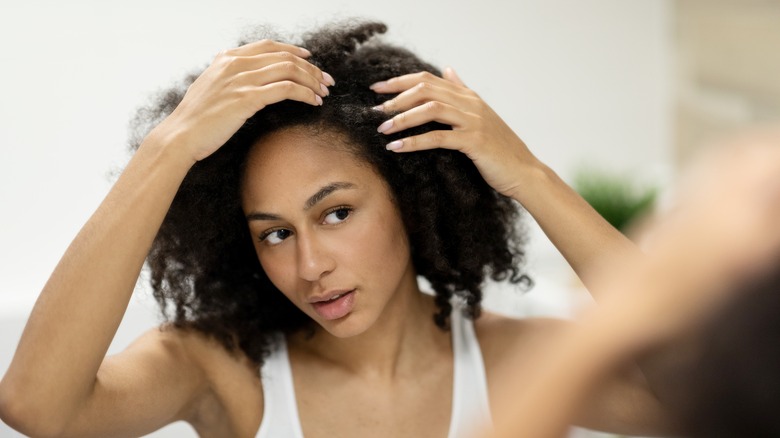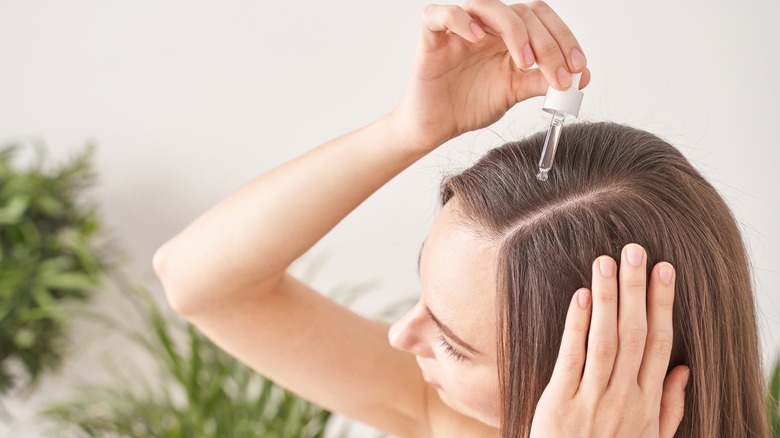Turns Out Witch Hazel Isn't Just A Skincare Superstar - It Benefits Your Hair, Too
It's common knowledge that witch hazel does wonders for your skin — after all, it helps with everything from frustrating adult acne to inflammation. But did you know that it can also address certain hair issues? Witch hazel is mainly used as a topical agent and contains naturally occurring healing chemicals called tannins, which are derived from plants. The anti-inflammatory ingredient helps with common skin ailments such as sunburns, bug bites, and eczema. One condition you may not have heard of is scalp burnout, which irritates the skin in response to large amounts of fatigue, but shampoos containing witch hazel have been shown to improve the condition.
You don't have to have an ailment to reap the benefits of witch hazel for your hair. Just like its uses for the face, incorporating the astringent into your daily grooming habits can do wonders for your strands. From giving your scalp a refreshing cleanse to making your hair look healthier, we're looking at the wonder potion in a whole new light.
Witch hazel can help with dry and itchy scalp
Your hair health begins with your scalp, and if things are awry below your roots, they'll ultimately affect your strands. More specifically, if you struggle with dry scalp or dandruff, witch hazel may be the answer to your problems. "Witch hazel is a natural astringent often used to soothe irritated and red skin, which is exactly what it would do for your scalp," dermatologist Dr. Kavita Mariwalla told Healthline. It can also help with flaking, itchiness, and skin inflammation, and if you're prone to oily roots, witch hazel can combat that, too. "Witch hazel also benefits greasy hair since it is known to absorb excess oil, resulting in full, shiny hair," Dr. Mariwalla added.
Witch hazel also aids your scalp by shrinking its pores. "There is a belief that the vasoconstrictive properties — narrowing of the blood vessels — assists with anchoring in the hair follicle and increases blood circulation directly to the follicle," trichologist Bridgette Hill shared with Byrdie. This sounds like a dream, but you may be wondering how you can adopt witch hazel into your haircare routine. Thankfully, there are several ways you can achieve these results, and almost all of them start by addressing the roots.
Give your scalp a witch hazel treatment
Before you douse your hair with witch hazel, it's important to do a patch test on your scalp, as it may irritate sensitive skin. According to dermatologist Dr. Rachel Nazarian, this ingredient "has a slightly acidic pH," which can cause irritation (via MindBodyGreen). Witch hazel can also dry out your skin, so you may want to dilute it with water. If your patch test goes well, take a bit of alcohol-free witch hazel and pour a few drops on a cotton pad. Apply it to your scalp, and let it sit for about 10 minutes before you shampoo your hair.
One of the best ways to use witch hazel on your hair is to give your scalp some love with a massage. Speaking to Byrdie, dermatologist Dr. Ava Shamban suggested incorporating rosewater or chamomile tea into your witch hazel to water it down, as you shouldn't use it on your scalp at its full strength. You'll also want to add a "carrier oil like coconut or almond," according to Dr. Shamban.
"Using clean fingertips (never nails), massage in and around affected areas or scalp, in general, to oxygenate, circulate, lift, build-up and clarify," Dr. Shamban told Byrdie. While you're at it, try the hair-tapping technique to encourage scalp health and hair growth. "Then, brush the hair to help remove the build-up permanently. I recommend a combination of natural and synthetic bristles in small strokes from the center of the scalp away," Dr. Shamban added. As always, if you have a skin condition, consult your doctor before using a new product that could cause irritation.


